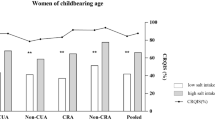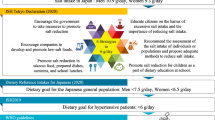Abstract
Background/objectives:
Salt iodization is one of the preferred strategies to eradicate iodine-deficiency disorders worldwide. The aim of this study was (i) to estimate the daily iodine intake in the Italian population, (ii) to verify whether the recently recommended salt intake of 5 g/day in adults and less in children may be sufficient to achieve the adequate daily iodine intake, (iii) to estimate the contribution of iodine-enriched vegetables to the total daily iodine intake.
Subjects/methods:
The content of iodine has been evaluated in 288 food samples highly representative of Italian eating habits. The contribution of foods and iodized salt to the total daily iodine intake was estimated in adults, adolescents, and children on the basis of available nationwide data of food consumption.
Results:
The total daily iodine intake owing to food and uniodized salt consumption resulted lower than the daily requirement in all age groups. With a daily consumption of 5 g of salt iodized at 30 mg/kg, the estimated daily iodine intake resulted within the range of optimal iodine intake in all age groups. In children the recommended iodine intake is achieved with a daily consumption of 3 g of iodized salt. Moreover, the daily iodine intake significantly increased in all age groups if the consumption of iodine-enriched vegetables was considered in substitution of non iodine-enriched ones.
Conclusions:
Our study suggests that the recommended quantities of salt, if iodized at 30 mg/kg, are sufficient to achieve the adequate daily iodine intake both in adults and children.
This is a preview of subscription content, access via your institution
Access options
Subscribe to this journal
Receive 12 print issues and online access
$259.00 per year
only $21.58 per issue
Buy this article
- Purchase on Springer Link
- Instant access to full article PDF
Prices may be subject to local taxes which are calculated during checkout

Similar content being viewed by others
References
Pearce EN, Andersson M, Zimmermann MB . Global iodine nutrition: where do we stand in 2013?. Thyroid 2013; 23: 523–528.
Delange F . Iodine deficiency as a cause of brain demage. Postgrad Med J 2001; 77: 217–220.
Zimmermann MB . Iodine deficiency. Endocr Rev 2009; 30: 376–408.
Bath SC, Steer CD, Golding J, Emmett P, Rayman MP . Effect of inadequate iodine status in UK pregnant women on cognitive outcomes in their children: results from the Avon Longitudinal Study of Parents and Children (ALSPAC). Lancet 2013; 382: 331–337.
WHO Expert consultation. Salt as a vehicle for fortification. 2007. Available at: http://whqlibdoc.who.int/publications/2008/9789241596787_eng.pdf.
UNICEF. Sustainable Elimination Of Iodine Deficiency: Progress Since 1990 World Summit For Children. United Nations Children’s Fund, New York, 2008. Available at: http://www.childinfo.org/files/idd_sustainable_elimination.pdf.
Haldimann M, Alt A, Blanc A, Blondeau K . Iodine content in food groups. J Food Comp Anal 2005; 18: 461–471.
Pearce EN, Pino S, He X, Bazrafshan HR, Lee SL, Braverman LE et al. Sources of dietary iodine: bread, cow’s milk, and infant formula in the Boston area. J Clin Endocrinol Metab 2004; 89: 3421–3424.
Dahl L, Johansson L, Julshamm K, Meltzer HM . The iodine content of Norvegian foods and diets. Public Health Nutr 2004; 7: 569–576.
WHO 2012 Guideline: Sodium intake for adults and children. Geneva, World Health Organization (WHO), Available at: http://www.who.int/nutrition/publications/guidelines/sodium_intake_printversion.pdf.
Leclercq C, Arcella D, Piccinelli R, Sette S, Le Donne C, Turrini A et al. The Italian National Food Consumption Survey INRAN-SCAI 2005–06: main results in terms of food consumption. Public Health Nutr 2009; 12: 2504–2532.
European Commitee for Standardization Foodstuffs - Determination of elements and their chemical species - General considerations and specific requirements, CEN - Management Centre Avenue Marnix 17 B-1000 Bruxels (B). UNI EN 13804:2013.
European Committee for Standardization Foodstuffs - Determination of trace elements - Determination of iodine by ICP-MS (inductively coupled plasma mass spectrometry). UNI EN 15111:2007.
WHO/UNICEF/ICCIDD. Assessment Of Iodine Deficiency Disorders And Monitoring Their Elimination. A Guide For Programme ManagersThird editionAnnex 1: Titration method for determining salt iodate and salt iodine content. World Health Organization: Geneva, 2007.
European Committee for Standardization General Requirements for the Competence of Testing and Calibration Laboratories.UNI CEI EN ISO/IEC 17025:2005.
Food and Nutrition Board of the Institute of Medicine of the National Academies Dietary reference intakes: the essential guide to nutrient requirements. The National Academies Press: Washington, DC, 2006.
EPA 6047, 2000 Assigning values to non-detected/non-quantified pesticide residues in human health food exposure assessments. Available at: http://www.epa.gov/oppfead1/trac/science/trac3b012.pdf.
Ladyman SR, Augustine RA, Grattan DR . Hormone interactions regulating energy balance during pregnancy. J Neuroendocrinol 2010; 22: 805–817.
WHO Secretariat Andersson M, WHO Secretariat de Benoist B, WHO Secretariat Delange F, WHO Secretariat Zupan J . WHO Secretariat Prevention and control of iodine deficiency in pregnant and lactating women and in children less than 2-years-old: Conclusions and recommendations of the technical consultation. Public Health Nutr 2007; 10: 1606–161.
Chavasit V, Malaivongse P, Judprasong K . Study on stability of iodine in iodated salt by use of different cooking model conditions. J Food Comp Anal 2002; 15: 265–276.
Diosady LL, Alberti JO, Venkatesh Mannar MG, Stone TG . Stability of iodine in iodized salt used for correction of iodine-deficiency disorders. Food Nutr Bull 1997; 18: 388–396.
Flachowsky G, Franke K, Meyer U, Leiterer M, Shone F . Influencing factors on iodine content of cow milk. Eur J Nutr 2013; 53: 351–365.
Watutantrige Fernando S, Barollo S, Nacamulli D, Pozza D, Giachetti D, Frigato F et al. Iodine status in schoolchildren living in northeast Italy: the importance of iodized-salt use and milk consumption. Eur J Clin Nutr 2013; 67: 366–370.
Tonacchera M, Dimida A, De Servi M, Frigeri M, Ferrarini E, De Marco G et al. Iodine fortification of vegetables improves human nutrition: in vivo evidence for a new model of iodine prophylaxis. J Clin Endocrinol Metab 2013; 98: E694–E697.
Zimmermann MB, Andersson M Assessment of iodine nutrition in populations: past, present, and future Nutr Rev 2012; 70: 553–570.
Thompson BM . Nutritional modelling: distributions of salt intake from processed foods in New Zeland. Br J Nutr 2009; 102: 757–765.
Ni Mhurchu C, Capelin C, Dunford EK, Webster JL, Neal BC, Jebb SA et al. Sodium content of processed foods in the United Kingdom: analysis of 44,000 foods purchased by 21,000 housholds. Am J Clin Nutr 2011; 93: 594–600.
Centers for Disease Control and Prevention. Vital signs: food categories contributing the most to sodium consumption—United States, 2007−2008. MMWR Morb Mortal Wkly Rep 2012; 61: 92–98.
Rasmussen LB, Jørgensen T, Perrild H, Knudsen N, Krejbjerg A, Laurberg P et al. Mandatory iodine fortification of bread and salt increases iodine excretion in adults in Denmark - A 11-year follow-up study. Clin Nutr 2013; e-pub ahead of print 9 November 2013; doi:10.1016/j.clnu.2013.10.024.
Verkaik-Kloosterman J, van’t Veer P, Ocke MC . Simulation model accurately estimates total dietary iodine intake. J Nutr 2009; 139: 1419–1425.
Zimmermann MB . Iodine deficiency in industrialized countries. Clin Endocrinol 2011; 75: 287–288.
Osservatorio Nazionale per il Monitoraggio della Iodoprofilassi in Italia Attività di sorveglianza – Dati Nazionali 2011. Available at: http://www.iss.it/osnami/index.php?lang=1&anno=2014&tipo=21.
Jahreis G, Hausmann W, Kiessling G, Franke K, Leiterer M . Bioavailability of iodine from normal diets rich in dairy products—results of balance studies in women. Exp Clin Endocrinol Diabetes 2001; 109: 163–167.
Acknowledgements
We thank Daniela Rotondi for her technical assistance. This research was supported by the Istituto Superiore di Sanità grant No. 3AQC.
Author information
Authors and Affiliations
Corresponding author
Ethics declarations
Competing interests
The authors declare no conflict of interest.
Rights and permissions
About this article
Cite this article
Pastorelli, A., Stacchini, P. & Olivieri, A. Daily iodine intake and the impact of salt reduction on iodine prophylaxis in the Italian population. Eur J Clin Nutr 69, 211–215 (2015). https://doi.org/10.1038/ejcn.2014.206
Received:
Revised:
Accepted:
Published:
Issue Date:
DOI: https://doi.org/10.1038/ejcn.2014.206
This article is cited by
-
The effect of sodium restriction on iodine prophylaxis: a review
Journal of Endocrinological Investigation (2022)
-
Sources and hydrogeological conditions that cause high iodine concentrations in deep groundwater in the Zhangwei watershed, North China Plain
Environmental Earth Sciences (2021)
-
Relationship between salt consumption and iodine intake in a pediatric population
European Journal of Nutrition (2021)
-
Iodine nutrition in pregnant and breastfeeding women: sufficiency, deficiency, and supplementation
Hormones (2020)
-
Association of endemic goitre and exceptional longevity in Sardinia: evidence from an ecological study
European Journal of Ageing (2019)



